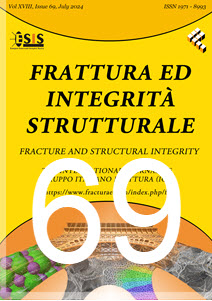Residual stress determination by blind hole drilling and local displacement mapping in aluminium alloy aerospace components
DOI:
https://doi.org/10.3221/IGF-ESIS.69.14Keywords:
residual stress, blind hole drilling method, speckle-pattern interferometry, well-posed inverse correlation problemAbstract
The determination of residual stresses by combining blind hole drilling and optical interferometric measurement of relief deformation is re-visited to evaluate its applicability to aerospace structures. The experimental methodology involves drilling a deep blind hole and evaluating the hole diameter increments in the principal strain directions using electronic speckle-pattern interferometry (ESPI). This is followed by the determination of the principal residual stress components via the solution of the inverse correlation problem. The study presents the pathway to overcoming one of the primary obstacles in residual stress determination, namely, the optimization of the measurement and interpretation procedures to obtain reliable results. It can be concluded from the analysis of the problem that the formulae connecting the raw experimental data and to the sought residual stress component values lead to a well-posed inverse problem. This makes it possible to obtain estimations of the measurement uncertainty. High density fringe patterns from ESPI provide a rapid and reliable method for residual stress determination, as illustrated using examples of approximately 160 MPa stresses in irregular zones of thick-walled structures.
Downloads
Downloads
Published
Issue
Section
Categories
License
Copyright (c) 2024 Sviatoslav Eleonsky, Vladimir Pisarev, Eugene Statnik, Alexey Salimon, Alexander Korsunsky

This work is licensed under a Creative Commons Attribution 4.0 International License.
Copyright
Authors are allowed to retain both the copyright and the publishing rights of their articles without restrictions.
Open Access Statement
Frattura ed Integrità Strutturale (Fracture and Structural Integrity, F&SI) is an open-access journal which means that all content is freely available without charge to the user or his/her institution. Users are allowed to read, download, copy, distribute, print, search, or link to the full texts of the articles in this journal without asking prior permission from the publisher or the author. This is in accordance with the DOAI definition of open access.
F&SI operates under the Creative Commons Licence Attribution 4.0 International (CC-BY 4.0). This allows to copy and redistribute the material in any medium or format, to remix, transform and build upon the material for any purpose, even commercially, but giving appropriate credit and providing a link to the license and indicating if changes were made.




































